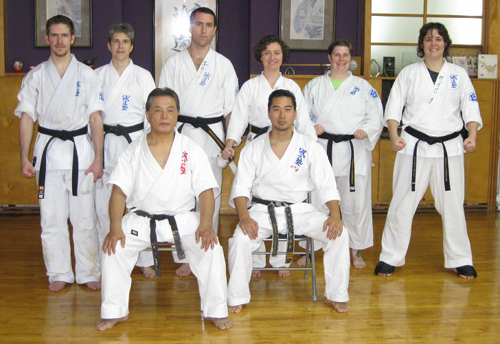2020 February
2018 December August June February
2017 December September June March
2016 November August June March
2015 December October July May February
2014 December October July April February
2013 December October August May February
2012 December September July April February
2011 December September July April February
from the October, 2009 issue of Kiai!
Report from Senior Black Belt Testing
On Wednesday October 7th Eric Franque, Kathy Tanner and Ben Samuels-Kalou shared their recent experiences at Honbu, the headquarters of the World Seido Karate Organization in New York City, where the karate-ka tested for advanced promotions. Eric Franque is now a third degree black belt, Kathy Tanner is now a second degree black belt and Ben Samuels-Kalou is a first degree black belt. Joy Williamson, the head of our sister school Sun Dragon in Austin, Texas also tested and was promoted to second degree black belt.

Eric
My first impression of Honbu was that it was big, had two floors and hundreds of students yet it was still welcoming. The first chunk of our test was for karate-ka testing for Shodan (first degree black belt), and consisted mostly of basics, kata, and essay presentations. There were lots of senior students around.
Kaicho (the Grandmaster of Seido Karate) asked everyone to present their favorite kata. I choose Seido Five. When I finished Kaicho asked me, "Does your head face front or back during the back kick?" I thought this over, realized my head had faced front when it should have faced back. I responded, "To the back, Kaicho."
"Are you sure? Because your head faced the other way." Then warmly, "Maybe you did that because this is your first night in New York and you are very nervous?" These technical yet understanding statements was emblematic of Kaicho's attitude throughout the test.
During the test, I got to have tea with Kaicho, a calm and quiet encounter and a unique cultural experience.
Training during the four to six weeks prior to going to Honbu was engaging. I really delved into self-training and got a chance to practice kata in Colorado's Rocky Mountains. I heightened my mental focus in class and concentrated on being present. I also immersed myself answering my essay question, "How do you measure the spirit of individuals in your teaching?"
Kathy
I actually studied at Honbu until I got my green belt, and reconnected with several people I knew while I trained there, particularly the senior students. I have a lot of gratitude towards my fellow promotees, who supported me and represented Thousand Waves extremely well.
This test was unusual for me because it lasted for five days and there were lots of different testing groups, so you never knew what you were doing until it happened. The test was more technical than I expected; we spend a half hour on mushubi dachi (a type of stance). My biggest challenge was concentrating and remaining present.
Compared to Thousand Waves, where I know people in partnership exercises, partnerships at Honbu could have potentially felt peculiar. However, since essay presentations occurred before sparring, and were quite heartfelt, I felt like I knew people before sparring them.
For me, training before the test was more important than the test itself. I went to New York feeling confident about my fitness and knowledge of the material.
Ben
I arrived in New York after everyone else, so my first night of testing was with junior black belts, which was unique since I'm 19 and have a beard. I was nervous. I presented my essay at this time, answering "Who in your life has influenced you the most? I was pleasantly surprised by how supported I felt, not just as a martial artist but as a thinking person, by the questions people asked.
Later on in the test, I presented Kihon Five. When I was finished Kaicho said I had invented Kihon Twelve since I started with Kihon Five but ended with Kihon Seven. Kaicho's humor is quite functional in easing stress in situations like that. I felt like a hundred thousand senior blacks were watching me.
Sparring at Honbu was unusual for me, the first time I experienced semi-contact. Kyoshi Sarah warned me ahead of time this would be challenging. I hadn't had an asthma attack for years, and after particularly challenging round I had trouble breathing. I stepped out of next round to use my inhaler and catch my breath. When returned I heard the voice of every single teacher I ever had, "Fight Smart. Footwork. Combinations. Breathe."
Jun Shihan Nancy, Kyoshi Sarah Ludden
Jun Shihan Nancy Lanoue made a crucial point that testing for promotions begins the moment one is invited to test and that pre-test training is equally, if not more important than the test itself. She also said that these tests were an opportunity for her and other senior Thousand Waves teachers to see what movements have been maintained and what has been changed. Seido Karate is a living art and it does change, sometimes on purpose and sometimes inadvertently.
Kyoshi Sarah Ludden expressed warm appreciation for the individuals who tested. She recognized their training and growth, particularly in their power and fluidity. She commented that their contributions to classes were palpable and helped the continuation of the school and the art of Seido Karate.
